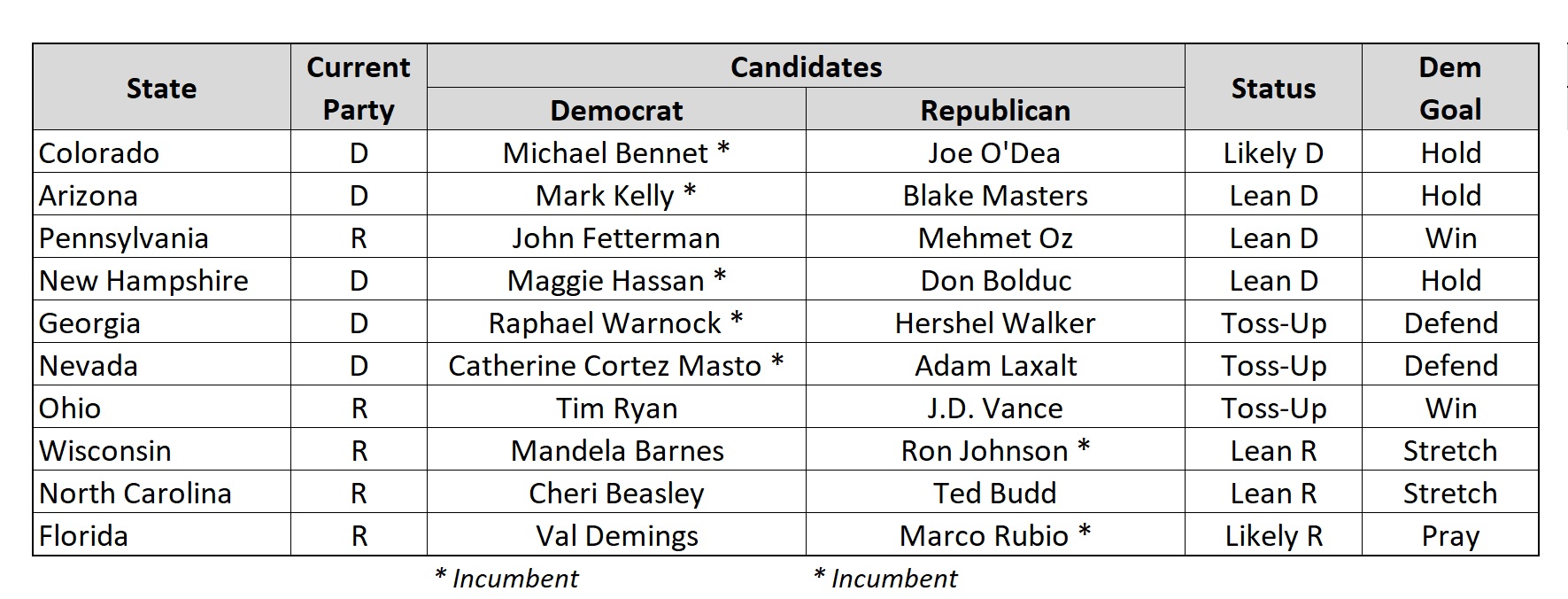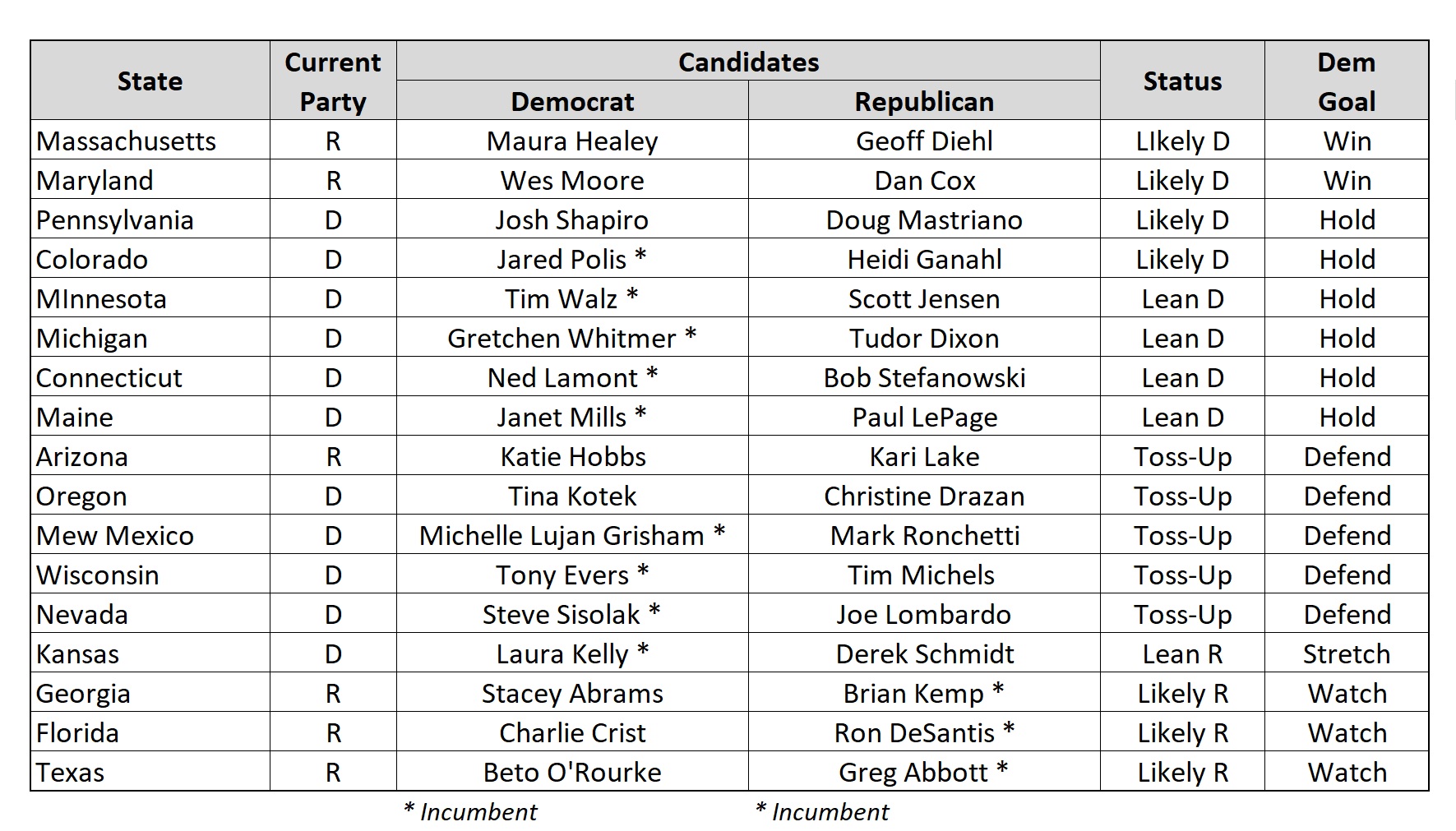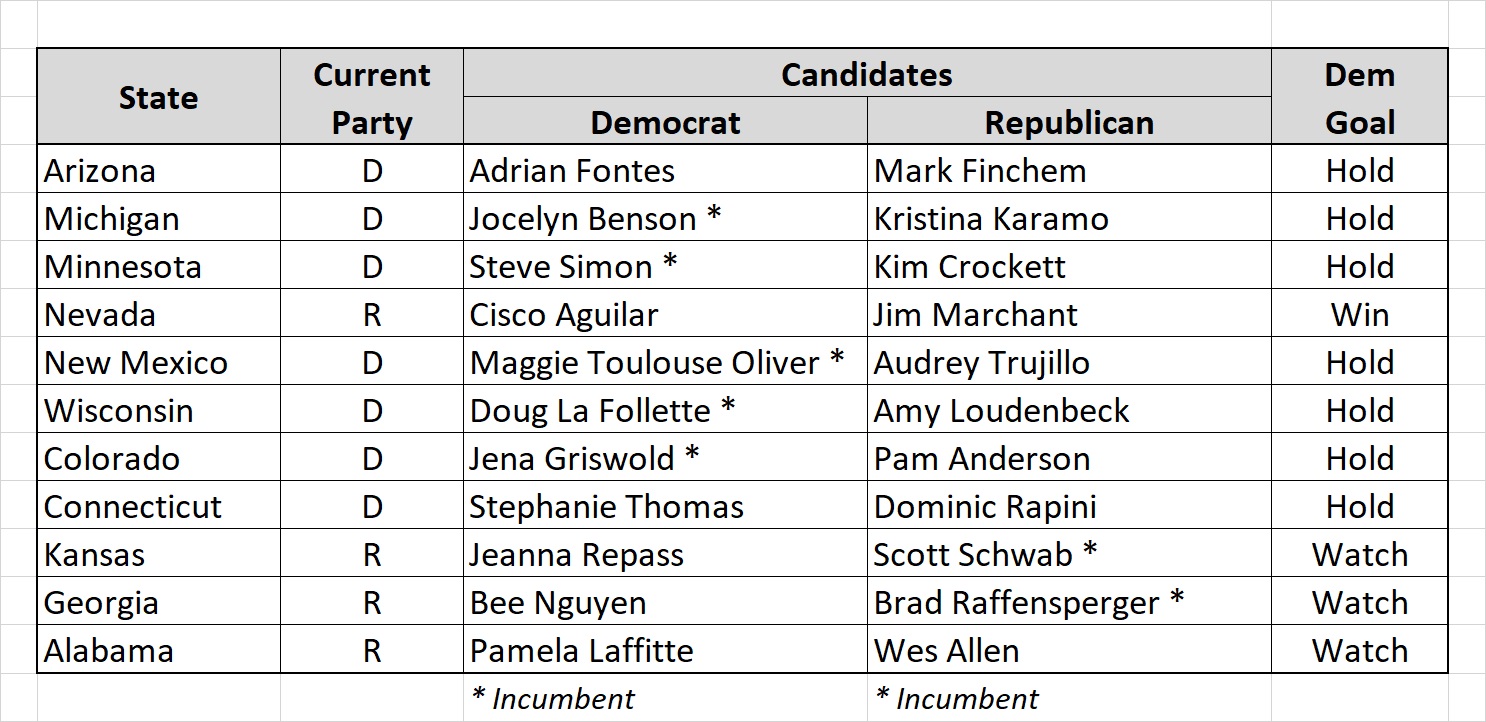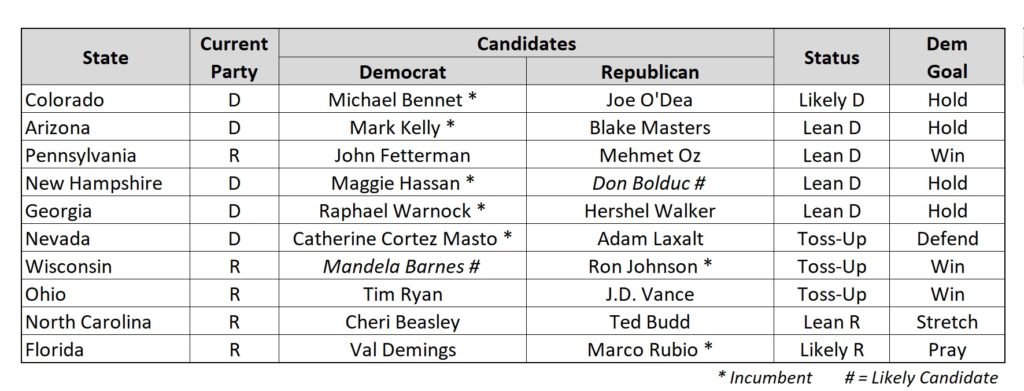In premature anticipation of Georgia once again being the deciding factor in party control of the Senate, I’d started writing down my thoughts on the 12/6 runoff between Raphael Warnock and Herschel Walker.
However, with the win in Nevada by Catherine Cortez Masto over Adam Laxalt, Democrats will retain control of the Senate even without Georgia! I am absolutely thrilled that my NV fears proved to be unfounded. While Democrats still need to fight hard to win in Georgia, the Georgia Senate race is no longer the doorway between Good and Evil. (And that’s only a slight exaggeration.)
Thus, although I fully intended to seriously edit and mold this disjoint collection of Peach State musings into a shorter, more coherent, and moderately well-structured post, that’s just not happening now. You’re getting my fairly raw, stream-of-consciousness notes. Live with it.
Runoff Importance
Democrats will maintain their Senate majority with or without the Georgia Senate seat. That does not, however, mean that the race is unimportant.
In addition to padding their majority so that no one Democratic Senator can dictate policy (ala Joe Manchin), there is a major structural advantage to having 51 seats as opposed to 50. In the latter case, the VP can break a tie on the floor of the Senate – and was often called upon to do so. However, seats on Senate committees are not distributed using the VP’s vote. Currently, the seats on all Senate committees are evenly split between both parties. This has resulted in the committees being largely hamstrung with tie votes. In turn, many things that could have been resolved in committees required action on the Senate floor – an inevitable, but time-consuming process that Republicans have used to significantly delay progress.
That one extra vote could make things a whole lot easier for Senate Democrats over the next two years.
Georgia Politics
Despite the fact that both of Georgia’s current U.S. Senators are Democrats, let’s be clear: Both of them barely won their runoff elections in 2020 primarily due to the Orange Guy’s obsession with overturning his own loss in Georgia. While I won’t discount the phenomenal strides that Democrats have made in Georgia (more on that in a moment), the Georgia GOP owns a state trifecta – the Governor’s office and both legislative chambers – in addition to the offices of the Lt. Governor, the Secretary of State, and the Attorney General.
Democrats are the red-shirted extras on the set of the Georgia Enterprise who managed to land a couple of guest-starring roles while everyone was watching an executive producer try to bang the whole special effects department on the craft services table. (Go ahead. Parse THAT analogy.)
With a decent GOP Senate candidate in a mid-term election with an unpopular Democratic President, Warnock should have been easily beatable in Georgia.
However, the Orange Guy once again stepped in to declare that Walker should be the 2022 GOP Senate nominee with the sole “logic” being that the best choice to defeat a black pastor would be a black sports figure who pledged orange fealty. Of course, the black citizens of Georgia aren’t stupid. Only 8% of black voters in Georgia chose Walker. Black women were even less impressed, giving Walker only 5% of their votes.
On the other hand, 70% of white Georgians voted for Walker. Of particular interest is that 88% of self-identifying white evangelicals voted for the morally bankrupt Walker over the guy with a friggin’ doctorate in theology who is a pastor of one of Atlanta’s most revered Baptist churches. While that incredible hypocrisy no longer surprises me, it still irritates my soul.
The Democratic Renaissance in Georgia
The 2020 elections saw Democrats make considerable gains in organization, enthusiasm, and voter registration. That surge was largely led by Stacey Abrams and her Fair Fight PAC. While she lost her own 2018 and 2022 bids for Governor, her efforts were uniquely instrumental in the 2020 Democratic wins in Georgia for President and for both Senate seats. Her importance to the Georgia Democratic Party cannot be overstated. However, while she is extremely smart, she can often be polarizing and is perceived as a bit too overtly ambitious – even for a professional politician. She publicly sought Biden’s VP nod when such lobbying is generally frowned upon; she seriously overplayed her hand when pursuing some initially valid concerns about the fairness of her first Governor’s race; she allowed herself to be cast as a guest star in “Star Trek: Discovery” as the President of United Earth.
Still, Abrams’ involvement and full-throated support is absolutely essential to Warnock’s runoff campaign. It’s likely that she could single-handedly deliver (or de-motivate) the Black Woman vote – which is perhaps the Georgia Democratic Party’s most loyal constituency. Since Abrams is undoubted disheartened by her own election loss, Georgia and national Democrats should quickly give this woman something to keep her deeply involved.
Walker’s Georgia Bona Fides
This really needs to be made a bigger issue that it’s been.
Yes, Walker won the Heisman in 1982 while playing for the University of Georgia. Got it. His campaign repeats this one resume item like he cured cancer while walking on the moon. Damn, folks. He won a college sports award 40 years ago! Give it a rest.
After leaving college (without graduating), Walker quickly bolted from Georgia. He spent three seasons playing for the USFL’s New Jersey Generals until that league folded. He then played for the Dallas Cowboys for two years before being traded to the Minnesota Vikings, then to the Philadelphia Eagles, then to the New York Giants, and finally back to the Dallas Cowboys as a backup. His 12-year NFL career was unremarkable and, notably, the Atlanta Falcons were NOT one of his pitstops. Walker has no Super Bowl ring and, in fact, only saw the field in five playoff games for a combined 28 carries resulting in a grand total of 132 yards and zero touchdowns. Woo.
And, by the way, in second place for the 1982 Heisman? John Elway and his TWO Super Bowl rings. So much for the Heisman’s prediction of NFL success.
Walker retired to Westlake, Texas and didn’t move back to Georgia until 2021 – specifically to establish residency for his Senate run. His response to being called a carpetbagger? “I think the people made a mistake by saying I’m not a Georgian. I’ve always thought about Georgia. I’ve lived in Georgia.”
Hey, I used to live in Germany and I still think about it. Scheisse! Does that mean I’m German?
Walker is an Idiot
While this topic has at least been raised, it needs to be hammered home during the runoff campaign. Here’s just a few quotes, provided without commentary:
- On climate change mitigation:
- “A lot of the money is going into trees. We’ve got enough trees. Don’t we have enough trees around here?”
- On pollution:
- “Since we don’t control the air, our good air decided to float over to China’s bad air, so when China gets our good air, their bad air got to move. So it moves over to our good air space. Then, now, we got we to clean that back up.”
- On women’s Issues:
- “This economy is tough because they gotta buy groceries.”
- On Georgia being ranked in the bottom half of states in education, health care, crime, environment, etc.:
- “If it’s the worst state, why are you here? Why don’t you leave? Go to another – there’s, what, 51 more other states that you can go to?”
- On his custom COVID solution:
- “You know, right now I have something that can bring you into a building that would clean you from COVID as you walk through this dry mist. As you walk through the door it will kill any COVID on your body. When you leave the building it will kill the virus.”
- On school shootings, less than two days after the Uvalde incident:
- “Cain killed Abel and that’s a problem that we have. What we need to do is look into how we can stop those things. You know, you talked about doing a disinformation — what about getting a department that can look at young men that’s looking at women that’s looking at their social media. What about doing that? Looking into things like that and we can stop that that way. But yet they want to just continue to talk about taking away your constitutional rights. And I think there’s more things we need to look into. This has been happening for years and the way we stop it is putting money into the mental health field, by putting money into other departments rather than departments that want to take away your rights.”
Walker is a Liar
Not only is Walker a compulsive liar, he’s a laughably bad liar. Seriously. If you’re inclined to lie at all, why on Earth would you choose to lie about things that are quite easy to verify? Here’s just a few highlights:
- “If you have a child with a woman, even if you have to leave that woman — even if you have to leave that woman — you don’t leave that child.”
- “As a Christian, a father, and a husband, Herschel knows that strong families are the bedrock of our country.” [from his website]
- While basing his campaign on a “family values” schtick, he assumed that the media wouldn’t find out that the fathered not one, but four children by different women and has been largely uninvolved in their lives. He assumed that the media wouldn’t find out that he also paid for one or more abortions. As the details trickled out, he just continued to lie. He lied about it to his own campaign. He lied about it after his own son called him out as a liar and a horrible father. Well beyond the considerable moral issues here, the blatant lies in the face of hard evidence are impossible to defend.
- ‘I … was in the top 1% of my graduating class in college.”
- He was not. He never even graduated from college.
- “I worked for law enforcement, y’all didn’t know that either?”
- Walker has variously and repeatedly claimed to be a sheriff, a peace officer, and an FBI agent – often brandishing fake badges as “proof”. The Georgia Sheriff’s Association had to release a statement that the honorary badge Walker flashed in a debate has “no specific law enforcement authority.” They went on to say that they’ve now stopped handing them out, fearing they could be used to impersonate a police officer – which is a felony in Georgia.
- “My mom just told me that my grandmother was full-blood Cherokee. So I’m Native American!”
- No, he’s not. Walker has offered no proof and none of the Cherokee tribes recognize any family connection whatsoever. Where are the Republicans who lambasted Elizabeth Warren for her similar claims?
- “I’m this country boy. I’m not that smart.”
- Well, okay. I’ll give him that one.
Runoff Analysis & Gameplan
I briefly considered building a new predictive model for the GA runoff election before quickly realizing that there’s only data point that matters: The very recent state-sponsored “poll” that was conducted using all of Georgia’s actual voters in the general election. Warnock won a plurality with some 35K more votes than Walker. That’s a good number, but it’s not a safe number.
The runoff is all about executing a solid turnout ground game and I see four primary goals:
- Get Warnock Voters to Vote Again
- By far the biggest chore is to convince Democratic voters in GA to turn out One More Time. The Warnock campaign has access to the profiles of everyone that voted and can quite accurately identify those individuals who likely voted for Warnock. These people need to be individually contacted and asked to please vote again. Yes, that’s close to 2M voters. I didn’t say it would be easy.
- Turn out Warnock Profiled Voters Who Didn’t Vote
- By the same token, Democrats have access to the profiles of every registered voter that DIDN’T vote and can quite accurately identify those individuals who would have likely voted for Warnock using the demographics of the voters who DID vote. Sets of these individuals need to be contacted and convinced that their vote matters.
- For example, while the public data isn’t quite complete yet, it appears that only 14% of GA registered voters under the age of 30 voted in the general election, well below the national average of 27%. Since that demographic nationally tended to heavily favor Democrats, young people might be a good target audience for GA Democrats to collect some new votes.
- Win Over the Libertarian Voters
- Around 81K voters chose the Libertarian candidate. Historically, Libertarians have been more likely to lean Republican due to the GOP’s traditional small-government stance. However, that’s the GOP of the past. With these voters, Democrats need to hammer Walker primarily over women’s rights and the GOP’s desire to dictate their healthcare choices.
- For the practical Libertarians, I’d also pose this question: Would you rather have a Senator in a slim majority who can possibly tilt legislation to favor Georgia or would you rather have a Senator in the minority with no leverage whatsoever?
- De-Motivate Walker Voters from Voting Again
- At this point, while no minds will be changed, it is possible that some Walker voters simply won’t participate in the runoff – and every Walker voter that doesn’t repeat is a vote for Warnock. This isn’t a one-on-one problem, but the seeds needs to be planted, both online and in the media, that voting for Walker again isn’t worth any Republican’s time.
- I contend that many Georgia Republicans knew that Walker was an insincere imbecile. They just didn’t care as long as he was willing to toe the party line. This quote from Dana Loesch, a former NRA spokesperson, says it all: “I don’t care if Herschel Walker paid to abort endangered baby eagles. I want control of the Senate.” Sorry, Dana. While your honesty is appreciated, that just ain’t gonna happen now. So why waste any more effort on this idiot?
There’s a debate scheduled for Monday, 11/21 and the Warnock campaign needs to remember the above. People have already made up their minds on the issues and the focus now needs to be on turnout.
Runoff Wishes
I’ll shortly be sending the Warnock runoff campaign some money. However, I’d like to make just a few requests if they expect me to donate any further…
- I understand that emails are a free way for you to solicit donations. But please! Stop sending the same damn formulaic emails and stop sending them multiple times a day. Also try to display a modicum of pride and stop groveling for money. For the Love of God: Hire a good, clever writer that can make folks actually want to read your campaign emails. If they are brilliant pieces of literature, you can send one a day. If they’re merely readable, make it no more than twice a week. Otherwise, you’re just pissing me off.
- Please don’t send texts to people outside of Georgia. That’s just annoying. Your profile of me tells you that I’m not a GA voter so don’t make me a target of your “Get Out The Vote” effort.
- Spend some money to create a few great ads that can quickly go viral. Humor works wonders. As a bonus, you can get away with being a whole lot meaner if you’re also funny. There’s a ton of excellent comedy talent that would love to help. Reach out with a check. People are SO. VERY. TIRED. of this election. They’re particularly tired of being bombarded by variations of the same crappy political ads set to different royalty-free, talent-free music. Give people a reason to smile and they’re much more likely to give you their money and/or their vote.
Donate!!
Any money is good, but early money is best. I’d already donated to Warnock’s general election campaign but I’ll be sending another contribution today to support the runoff campaign via ActBlue. Contribute if you can!




